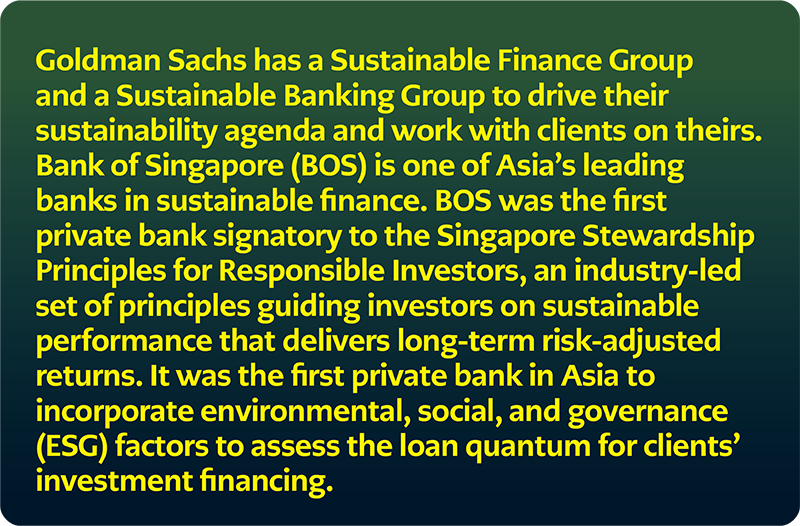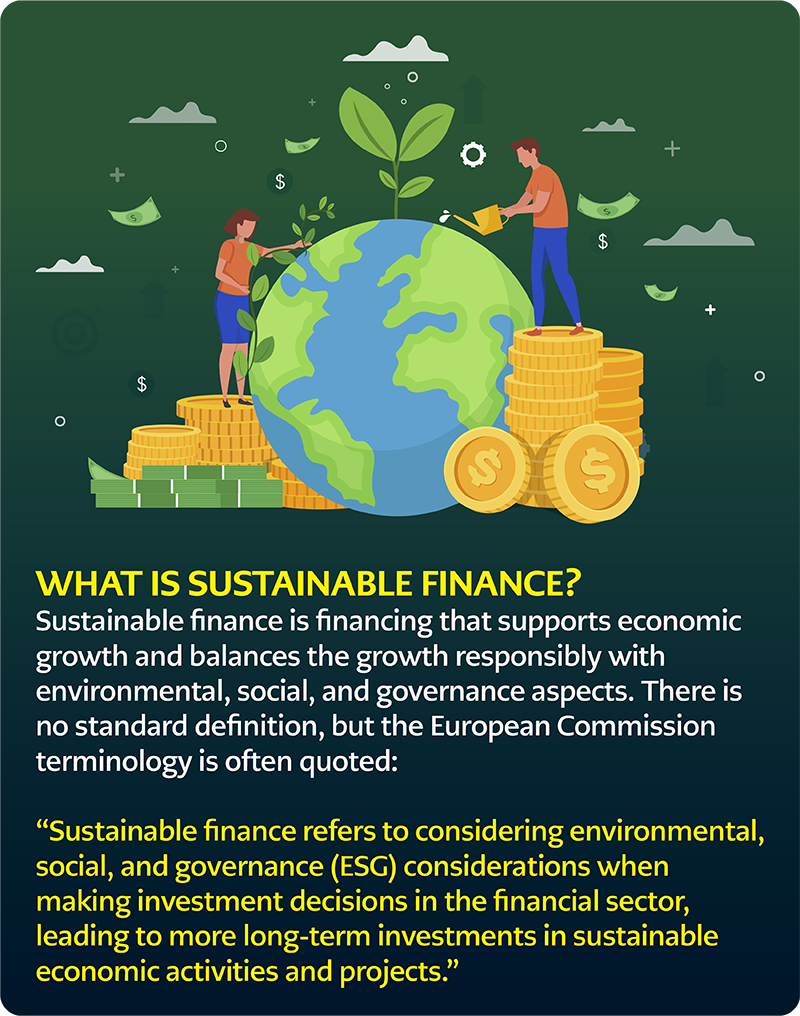The Role of Artificial Intelligence in Sustainable Financing
Organisations are gradually seeing how the intersection of AI and sustainable finance can generate value by mainly reshaping communications.

By Dr Angelica Lim
Sustainability is no longer just a feel-good topic but one of broad and current interest. In the corporate world, sustainability has evolved from being primarily a public-relations topic for communicating with stakeholders and mitigating potential reputation risks. Instead, sustainability is a vital aspect of a company’s strategy and operations. To ensure that this crucial area has the appropriate leadership attention and engagement, some organisations have included a position focused on sustainability in their most senior leadership team; for example — Maria Luiza de Oliveira Pinto e Paiva is Vale’s Executive Vice-President, Sustainability; Pär Stenmark leads Ikea’s sustainability agenda; and closer to home, Charlotte Wolff-Bye is PETRONAS’ Vice President and Chief Sustainability Officer.
A critical aspect that companies need to consider is how sustainability affects their ability to access capital. Why should financial institutions use their limited capital to invest in your business or lend money to your company? More and more, financial institutions are incorporating sustainability to support their investments/lending decisions — a concept called sustainable finance.

Here in Malaysia, CIMB Group has a Sustainable Finance Framework that includes, amongst other things, sustainability investment and lending guidelines for maximising positive impact and minimising harm. The framework also comprises CIMB Group’s position statements on the industry sectors they deem high sustainability risks.

However, just like no one standard definition for sustainable finance, there is also no globally accepted standard set of metrics for reporting on and measuring a company’s sustainability performance. There are, however, a few reporting frameworks that organisations have adopted. One of the more widely used frameworks is the Global Reporting Initiative Standards (GRI Standards). The GRI Standards is a comprehensive set of three reporting frameworks: the GRI Universal Standards that apply to all organisations, the GRI Sector Standards that cover information relevant to 40 different sections, and finally, the GRI Topic Standards for reporting on specific topics (like occupational health & safety or waste). Another frequently used framework is the Sustainability Accounting Standards Board Standards (SASB Standards), which covers 77 industries. Lending weight to the SASB Standards is that it is under the purview of the International Sustainability Standards Board (ISSB) of the International Financial Reporting Standards (IFRS) Foundation.
Organisations align with one (or more) sustainability standards depending on stakeholder expectations, industry, and geographic locations. The lack of a universally adopted framework for measuring a company’s sustainability performance and the plethora of different sustainability metrics add significant challenges to the complex decision-making required of sustainable finance. A financial institution would have a sustainable finance framework for assessing its potential clients. However, these potential clients’ organisations will likely have measurements that differ from company to company. Financial institutions must gather and transform various data from heterogeneous companies and ensure equitable and consistent assessment before making financing decisions. With such challenges, AI is well-placed to provide multi-faceted support to financial institutions in their sustainable finance endeavours.

Numerous sustainability metrics and the absence of a universal framework complicate the act of measuring the sustainability performance of companies.
AI tools are faster and more accurate than humans for collecting, cleansing, collating, and categorising data. AI algorithms can also rapidly analyse data and make recommendations (using generative AI).
One potent use of AI in sustainable finance is harnessing its power to look beyond the information provided by companies seeking capital from financial institutions. For example, one growing use of AI is assessing greenwashing by comparing company disclosures with external data. As per the latest Global Sustainable Investment Review (GSIR) issue, greenwashing is a growing risk for sustainable financing.

AI enhances climate change risk modelling, with CitiGroup estimating US$10 billion in loan losses if emissions reach net zero by 2050, US$3 billion more than without accelerated efforts.
Identifying greenwashing is an area of focus of the Natural Language Processing for Sustainable Finance Programme (NLP4SF), a collaboration between the Oxford Sustainable Finance Group and the University of Zurich’s Department of Banking and Finance. The programme identifies discrepancies between a company’s sustainability claims and results by harnessing the power of natural language processing (NLP) to compare company-provided information with actual activities.
Another critical area where AI is proving to be of value is in climate change risk modelling. In the previously mentioned GSIA report, climate change was the most vital ESG issue reported by money managers (across US$3.4 trillion in assets).
For example, in an analysis requested by the Federal Reserve, Reuters reported that CitiGroup modelled that the group faced potential loan losses of over US$10 billion over ten years if climate change efforts accelerated such that greenhouse gas emissions were reduced to zero on a net basis by 2050. This was US$3 billion more than the estimated US$7 billion losses if there was no acceleration in climate change efforts.

There are many more examples of how value can be generated through the intersection of AI and sustainable finance. Companies recognise this and are reshaping their communications accordingly — avoiding words commonly perceived negatively by AI algorithms and issuing communication utilising speech patterns and emotions that are positively analysed by these algorithms.
However, AI is not risk-free. The typical black-box nature of AI tools is one of the biggest criticisms. Data quality, bias in the algorithms, and ethical considerations are some of the other challenges. Notwithstanding the issues, using AI in sustainable finance is a transformation that will shape a very different financial landscape than today.
Having retired early from corporate roles, Dr Angelica Lim indulges in her passions for writing and travelling. She is also an investor, a lecturer at the Monash University Malaysia School of Information Technology, and a member of the Technical Advisory Panel to the Sustainable Finance Institute Asia.





